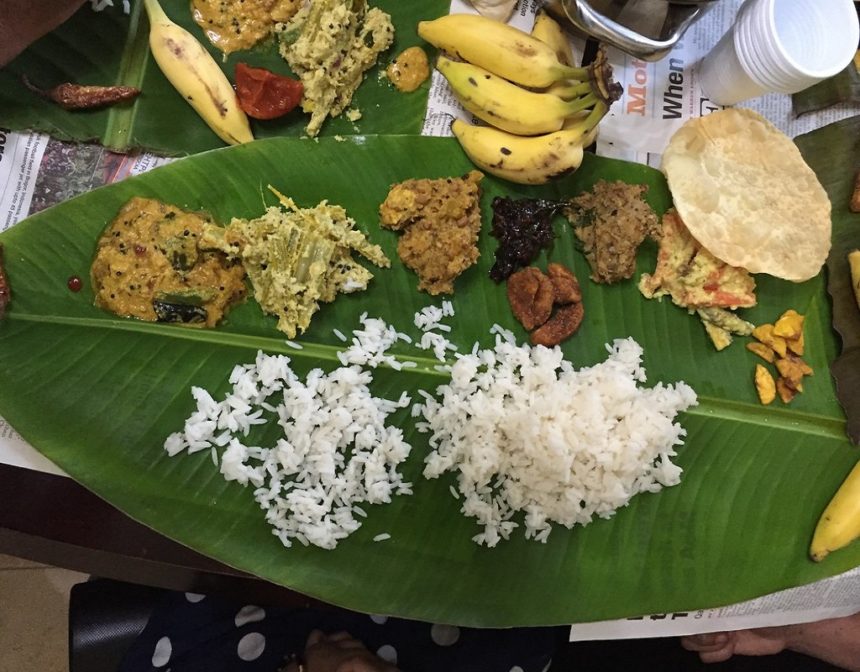There is a huge list of things that can make a Malayalee start to smack their lips, and stat salivating, as they begin to anticipate a gastronomic experience. Among the top tiers of these items is a full blown sadhya. In Kerala, food is something that is prized, above a lot of other aspects of life. Food, and forgive this generalisation, is something that most Malayalees live for.
You can expect then, in a culture that takes its cuisine seriously, that an event that qualifies as a feast would be something that is sacred and held as sacrosanct. The divine meal that is a sadhya is that, and a whole lot more. If you find yourself on a river cruise, meandering through the backwaters of Kerala, rest assured that you will experience some of the tastier parts of the cultural smorgasbord that is God’s Own Country.
Sadhyas are typically held after auspicious events such as marriages, naming ceremonies, etc. There are many forms of the sadhya, but a typical sadhya has anywhere from 24-28 dishes, all served in a single course. Typically conducted as lunch, there are lighter versions that can be arranged as dinner as well. Some sadhyas are held only on specific occasions, like the Villa Sadhya, which is eaten after the Aranmula Boatrace; or the Onam Sadhya, which is eaten on the occasion of Onam. These sadhyas can have many more dishes, sometimes going over 68 dishes. It is customary for these sadhyas to allow guests to ask the host for a surprise item, that has to have been prepared for.
The Preparation
As the date grows nearer, all ingredients would be prepped, the sourcing of all the ingredients being an elaborate and meticulous task, so that the quality in unsurpassed. The actual preparations would begin the night before the feast, so that all dishes are completed, ready and simmering, before 10 AM on the day of the celebration. The lighting of the fire to prepare the sadhya is traditionally done after praying to Agni, the god of fire, with the first offering served to him, symbolically in front of a lit nilavilallku, or lantern.
It is customary for the people of the neighbourhood to help out, spending the night helping the cooks. Some also volunteer to help serve the food to guests. So a sadhya becomes a social event that builds cohesion amongst the communities as well.
The Serving
All the dishes are presented and served to guests on a banana leaf. Traditionally, people used to sit on the floor, cross-legged, but now it has evolved to people sitting at tables with chairs. Since sadhyas are meant to serve a large number of people, they are set up in a way that there are waves of guests who come in different sittings. One wave will completely finish their meal, from starters to dessert in one course, and vacate the tables, allowing the next wave to come. When people are done, they will fold the leaf closed. In some instances, the way the leaf is closed can carry its own significance. Satisfaction is shown by the leaf being closed towards oneself, while folding it away from themselves can indicate that the meal can be improved upon. This can carry different connections as you travel regionally.
The Food
The mainstay of the sadhya is plain boiled rice, which is catapulted into different zones of flavour by the accompanying dishes, which are collectively called kootan. This includes curries like sambar, parippu, rasam, kaalan, pulisseri, avial, thoran, koottukari, erissery, pulinji, just to name a few. They are served along with achaars, and savoury items like papadams, plantain chips, sharkara uppers, and items like banana, plain curd, and servings of buttermilk. After this main portion of the meal is eaten, the traditional dessert of payasam is served at the end.
Sorry for the pause, the writer had to wipe away some drool from his mouth. Ahem. There can be as many as three types, and even more, ranging from the classic paal ada, ada pradhaman to chakkapradhaman. All the dishes that make up the kootan are made entirely from vegetables. This doesn’t mean that sadhyas are entirely vegetarian. The north of Kerala, for example, has a strong non-vegetarian presence in their sadhyas.
There is a specific order to the dishes placed on the leaf, and rules to where on the leaf they should be. Though this can vary from region to region, a journey which can make for an excellent Indian luxury river cruise, they largely reflect a common taste. Pickles are served on to the top left corner, while a banana will go to the bottom left of the leaf. This also allows servers to see what guests need, and where to give additional servings.




















Leave a Reply
You must be logged in to post a comment.